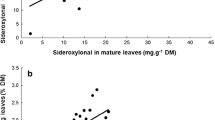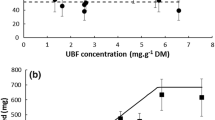Abstract
Plant secondary metabolites (PSMs) strongly influence diet selection by mammalian herbivores. Concentrations of PSMs vary within and among plant species, and across landscapes. Therefore, local adaptations may cause different populations of herbivores to differ in their ability to tolerate PSMs. Here, we tested the food intake responses of three populations of a marsupial folivore, the common brushtail possum (Trichosurus vulpecula Kerr), from different latitudes and habitat types, to four types of PSMs. We found clear variation in the responses of northern and southern Australian possums to PSMs. Brushtail possums from southern Australia showed marked decreases in food intake in response to all four PSMs, while the two populations from northern Australia were not as sensitive and their responses did not differ from one another. These results were unexpected, based on our understanding of the experiences of these populations with PSMs in the wild. Our results suggest that geographically separated populations of possums may have evolved differing abilities to cope with PSMs, as a result of local adaptation to their natural environments. Our results provide the basis for future studies to investigate the mechanisms by which populations of mammalian species differ in their ability to tolerate PSMs.




Similar content being viewed by others
References
Andrew NR, Hughes L (2005) Herbivore damage along a latitudinal gradient: relative impacts of different feeding guilds. Oikos 108:176–182
Ayres MP, Scriber JM (1994) Local adaptation to regional climates in Papilio canadensis (Lepidoptera: Papilionidae). Ecol Monogr 64:465–482
Bachmanov AA, Beauchamp GK (2007) Taste receptor genes. Annu Rev Nutr 27:389–414
Boland DJ, Brophy JJ, House APN (eds) (1991) Eucalyptus leaf oils. Use, chemistry, distillation and marketing. Inkata, Melbourne
Boyle R, McLean S, Foley WJ, Davies NW (1999) Comparative metabolism of dietary terpene, p-cymene, in generalist and specialist folivorous marsupials. J Chem Ecol 25:2109–2126
Boyle R, McLean S, Foley WJ, Moore BD, Davies NW, Brandon S (2000) Fate of the dietary terpene, p-cymene, in the male koala. J Chem Ecol 26:1095–1111
Brooker MIH, Kleinig DA (1990) Field guide to eucalypts, vol. 1. South-eastern Australia. Inkata, Melbourne
Brophy JJ, Goldsack RJ, Forster PI (2005) The leaf oils of the Australian species of Flindersia (Rutaceae). J Essent Oil Res 17:388–395
Bryant JP, Provenza FD, Pastor J, Reichardt PB, Clausen TP, Dutoit JT (1991) Interactions between woody-plants and browsing mammals mediated by secondary metabolites. Annu Rev Ecol Syst 22:431–446
Coley PD, Aide TM (1991) Comparison of herbivory and plant defences in temperate and tropical broad-leaved forests. In: Price PW, Lewinsohn TM, Fernandes GW, Benson WW (eds) Plant–animal interactions: evolutionary ecology in the tropical and temperate regions. Wiley, New York, pp 25–49
Coley PD, Bryant JP, Chapin FSI (1985) Resource availability and plant antiherbivore defence. Science 230:895–899
Dearing MD, Foley WJ, McLean SR (2005) The influence of plant secondary metabolites on the nutritional ecology of terrestrial herbivorous vertebrates. Annu Rev Ecol Evol Syst 36:169–189
DeGabriel JL, Moore BD, Foley WJ, Johnson CN (2009) The effects of plant defensive chemistry on nutrient availability predict reproductive success in a mammal. Ecology 90:711–719
Edwards WRN (1978) Effect of salicin content of palatability of Populus foliage to opossum (Trichosurus vulpecula). NZ J Sci 21:103–106
Eschler BM, Pass DM, Willis R, Foley WJ (2000) Distribution of foliar formylated phloroglucinol derivatives amongst Eucalyptus species. Biochem Syst Ecol 28:813–824
Foley WJ, Iason GR, McArthur C (1999) Role of plant secondary metabolites in the nutritional ecology of mammalian herbivores: how far have we come in 25 years? In: Jung H-JG, Fahey GCJ (eds) Nutritional ecology of herbivores: Proceedings of the Vth International Symposium on the Nutrition of Herbivores. American Society of Animal Science, Savoy, pp 130–209
Fox LR, Morrow PA (1981) Specialization: species property or local phenomenon? Science 211:887–893
Freeland WJ, Winter JW (1975) Evolutionary consequences of eating: Trichosurus vulpecula (Marsupialia) and the genus Eucalyptus. J Chem Ecol 1:439–455
Glendinning JI (1994) Is the bitter rejection response always adaptive? Physiol Behav 56:1217–1227
Hallam A, Read J (2006) Do tropical species invest more in anti-herbivore defence than temperate species? A test in Eucryphia (Cunoniaceae) in eastern Australia. J Trop Ecol 22:41–51
Hume ID, Esson C (1993) Nutrients, antinutrients and leaf selection by captive koalas (Phascolarctos cinereus). Aust J Zool 41:379–392
Iason G (2005) The role of plant secondary metabolites in mammalian herbivory: ecological perspectives. Proc Nutr Soc 64:123–131
Jones KMW, Maclagan SJ, Krockenberger AK (2006) Diet selection in the green ringtail possum (Pseudochirops archeri): a specialist folivore in a diverse forest. Austral Ecol 31:799–807
Kanowski J, Hopkins MS, Marsh H, Winter JW (2001) Ecological correlates of folivore abundance in north Queensland rainforests. Wildl Res 28:1–8
Kerle JA (2001) Possums. The brushtails, ringtails and greater glider. UNSW Press, Sydney
Lawler IR, Foley WJ, Eschler BM, Pass DM, Handasyde K (1998a) Intraspecific variation in Eucalyptus secondary metabolites determines food intake by folivorous marsupials. Oecologia 116:160–169
Lawler IR, Foley WJ, Pass GJ, Eschler BM (1998b) Administration of a 5HT3 receptor antagonist increases the intake of diets containing Eucalyptus secondary metabolites by marsupials. J Comp Physiol B Biochem Syst Environ Physiol 168:611–618
Lawler IR, Stapley J, Foley WJ, Eschler BM (1999) Ecological example of conditioned flavor aversion in plant–herbivore interactions: effect of terpenes of Eucalyptus leaves on feeding by common ringtail and brushtail possums. J Chem Ecol 25:401–415
Magnanou E, Malenke JR, Dearing MD (2009) Expression of biotransformation genes in woodrat (Neotoma) herbivores on novel and ancestral diets: identification of candidate genes responsible for dietary shifts. Mol Ecol 18:2401–2414
Mangione AM, Dearing MD, Karasov WH (2000) Interpopulation differences in tolerance to creosote bush resin in desert woodrats (Neotoma lepida). Ecology 81:2067–2076
Marsh KJ, Foley WJ, Cowling A, Wallis IR (2003) Differential susceptibility to Eucalyptus secondary compounds explains feeding by the common ringtail (Pseudocheirus peregrinus) and common brushtail possum (Trichosurus vulpecula). J Comp Physiol B Biochem Syst Environ Physiol 173:69–78
Marsh KJ, Wallis IR, McLean S, Sorensen JS, Foley WJ (2006) Conflicting demands on detoxification pathways influence how common brushtail possums choose their diets. Ecology 87:2103–2112
McArthur C, Sanson GD (1993) Nutritional effects and costs of a tannin in two marsupial arboreal folivores. Funct Ecol 7:697–703
McArthur C, Sanson GD, Beal AM (1995) Salivary proline-rich proteins in mammals—roles in oral homeostasis and counteracting dietary tannin. J Chem Ecol 21:663–691
McEachern MB, Eagles-Smith CA, Efferson CM, Van Vuren DH (2006) Evidence for local specialization in a generalist mammalian herbivore, Neotoma fuscipes. Oikos 113:440–448
McLean S, Pass GJ, Foley WJ, Brandon S, Davies NW (2001) Does excretion of secondary metabolites always involve a measurable metabolic cost? Fate of plant antifeedant salicin in common brushtail possum, Trichosurus vulpecula. J Chem Ecol 27:1077–1089
McLean S, Brandon S, Boyle RR, Wiggins NL (2008) Development of tolerance to the dietary plant secondary metabolite 1,8-cineole by the brushtail possum (Trichosurus vulpecula). J Chem Ecol 34:672–680
Moore BD, Wallis IR, Marsh KJ, Foley WJ (2004a) The role of nutrition in the conservation of the marsupial folivores of eucalypt forests. In: Lunney D (ed) Conservation of Australia’s forest fauna, 2nd edn. Royal Zoological Society of New South Wales, Mosman, pp 549–575
Moore BD, Wallis IR, Pala-Paul J, Brophy JJ, Willis RH, Foley WJ (2004b) Antiherbivore chemistry of Eucalyptus—cues and deterrents for marsupial folivores. J Chem Ecol 30:1743–1769
Moore BD, Foley WJ, Wallis IR, Cowling A, Handasyde KA (2005) A simple understanding of complex chemistry explains feeding preferences of koalas. Biol Lett 1:64–67
Nolte DL, Mason JR, Lewis SL (1994) Tolerance of bitter compounds by an herbivore, Cavia porcellus. J Chem Ecol 20:303–308
Osawa R, Sly LI (1992) Occurrence of tannin–protein complex degrading Streptococcus sp. in feces of various animals. Syst Appl Microbiol 15:144–147
Palo RT, Robbins CT (1991) Plant defenses against mammalian herbivory. CRC, Boca Raton
Pass GJ, Foley WJ (2000) Plant secondary metabolites as mammalian feeding deterrents: separating the effects of the taste of salicin from its post-ingestive consequences in the common brushtail possum (Trichosurus vulpecula). J Comp Physiol B Biochem Syst Environ Physiol 170:185–192
Procter-Gray E (1984) Dietary ecology of the coppery brushtail possum, green ringtail possum and Lumholtz’s tree kangaroo in north Queensland. In: Smith AP, Hume ID (eds) Possums and gliders. Surrey Beatty & Sons, Chipping-Norton, pp 129–135
Provenza FD (1995) Tracking variable environments—there is more than one kind of memory. J Chem Ecol 21:911–923
Ratkowsky DA, Evans MA, Alldredge JR (1993) Cross-over experiments: design, analysis, and application. Dekker, New York
Sasaki E, Shimada T, Osawa R, Nishitani Y, Spring S, Lang E (2005) Isolation of tannin-degrading bacteria isolated from feces of the Japanese large wood mouse, Apodemus speciosus, feeding on tannin-rich acorns. Syst Appl Microbiol 28:358–365
Shi P, Zhang JZ (2006) Contrasting modes of evolution between vertebrate sweet/umami receptor genes and bitter receptor genes. Mol Biol Evol 23:292–300
Shi P, Zhang JZ, Yang H, Zhang YP (2003) Adaptive diversification of bitter taste receptor genes in mammalian evolution. Mol Biol Evol 20:805–814
Shimada T (2006) Salivary proteins as a defense against dietary tannins. J Chem Ecol 32:1149–1163
Shimada T, Saitoh T, Sasaki E, Nishitani Y, Osawa R (2006) Role of tannin-binding salivary proteins and tannase-producing bacteria in the acclimation of the Japanese wood mouse to acorn tannins. J Chem Ecol 32:1165–1180
Stapley J, Foley WJ, Cunningham R, Eschler B (2000) How well can common brushtail possums regulate their intake of Eucalyptus toxins? J Comp Physiol B Biochem Syst Environ Physiol 170:211–218
Taylor AC, Foulkes J (2004) Molecules and morphology: a taxonomic analysis of the common brushtail possum Trichosurus vulpecula with an emphasis on the central Australian form. In: Goldingay RL, Jackson SM (eds) The biology of Australian possums and gliders. Surrey Beatty & Sons, Chipping-Norton
Torregrossa AM, Dearing MD (2009) Nutritional toxicology of mammals: regulated intake of plant secondary compounds. Funct Ecol 23:48–56
Twigg LE, King DR (1991) The impact of fluoroacetate-bearing vegetation on native-Australian fauna—a review. Oikos 61:412–430
Tyndale-Biscoe H (2005) Life of marsupials. CSIRO, Collingwood
Wallis IR, Watson ML, Foley WJ (2002) Secondary metabolites in Eucalyptus melliodora: field distribution and laboratory feeding choices by a generalist herbivore, the common brushtail possum. Aust J Zool 50:507–519
Wiggins NL, McArthur C, McLean S, Boyle R (2003) Effects of two plant secondary metabolites, cineole and gallic acid, on nightly feeding patterns of the common brushtail possum. J Chem Ecol 29:1447–1464
Acknowledgments
We thank Karen Marsh for help with trapping and care of the possums and Rob Gegg for technical and workshop assistance. We are grateful to Mark Brewer, Alex Douglas and Bob Forrester for statistical advice. Karen Marsh, Stuart McLean, Arlene McDowell and Ivan Lawler provided useful discussions and Glenn Iason commented on an earlier version of the manuscript. R. and E. Fryer and the Nasser family kindly allowed us to use their land. We thank Karen and Neil Coombes for their kind hospitality and assistance with trapping. We are grateful to Unitan for generously donating the quebracho. Funding was provided by grants from the Australian Research Council to C. N. J./A. K. K. and W. J. F. and the Australian National University to J. L. D. J. L. D. was supported by an Australian National University Graduate School Scholarship. This research was approved by the Queensland Government Environmental Protection Agency, the ACT Parks and Conservation Service and the Animal Experimentation Ethics Committees of the Australian National University and James Cook University, and conforms to the Australian Code of Practice for the Care and Use of Animals for Scientific Purposes.
Author information
Authors and Affiliations
Corresponding author
Additional information
Communicated by Mark Chappell.
Rights and permissions
About this article
Cite this article
DeGabriel, J.L., Moore, B.D., Shipley, L.A. et al. Inter-population differences in the tolerance of a marsupial folivore to plant secondary metabolites. Oecologia 161, 539–548 (2009). https://doi.org/10.1007/s00442-009-1407-9
Received:
Accepted:
Published:
Issue Date:
DOI: https://doi.org/10.1007/s00442-009-1407-9




